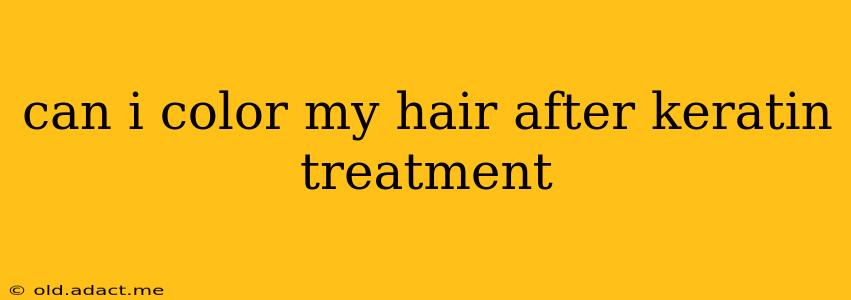The question of whether you can color your hair after a keratin treatment is a common one, and the answer isn't a simple yes or no. It depends on several factors, including the type of keratin treatment, the type of hair color you plan to use, and the timing of your color application. Let's delve into the details to help you make an informed decision.
What is a Keratin Treatment?
Before we address coloring, it's helpful to understand what a keratin treatment does. Keratin treatments are designed to smooth and straighten hair by infusing it with keratin, a protein naturally found in hair. This process helps to reduce frizz, improve shine, and make hair more manageable. However, the chemical process involved can impact how your hair reacts to subsequent coloring.
Can I Dye My Hair Immediately After a Keratin Treatment?
No, it's generally recommended to wait at least two to three days after a keratin treatment before coloring your hair. This waiting period allows the keratin solution to fully bond with your hair and minimizes the risk of the color being affected or the keratin treatment being compromised. Applying color too soon can interfere with the keratin's ability to properly seal the hair cuticle, potentially reducing the effectiveness of the treatment.
What Happens if I Color My Hair Too Soon After Keratin Treatment?
Coloring your hair too soon after a keratin treatment could lead to several undesirable outcomes:
- Uneven Color: The keratin treatment may prevent the hair color from penetrating evenly, resulting in patches of different shades.
- Faded Color: The keratin treatment could potentially lift or dilute the color, leading to a less vibrant result.
- Compromised Keratin Treatment: The chemicals in some hair colors might react negatively with the keratin solution, reducing its effectiveness and shortening its lifespan.
What Type of Hair Color Should I Use After Keratin Treatment?
Ideally, you should opt for demi-permanent or semi-permanent hair colors after a keratin treatment. These types of color contain less ammonia and peroxide, which are harsher chemicals that can damage the hair and potentially counteract the effects of the keratin treatment. Avoid permanent hair colors that are high in ammonia and peroxide as these are more likely to cause damage and disrupt the smoothing effects.
Can I Use Bleach or Highlights After Keratin Treatment?
This is a trickier situation. Bleach and highlights are generally discouraged soon after a keratin treatment. The bleaching process is highly chemical and can damage the hair's structure, potentially negating the benefits of the keratin treatment and causing dryness and breakage. If you absolutely must lighten your hair, it’s best to wait several weeks and consult with a professional hairstylist experienced in working with keratin-treated hair.
How Long Should I Wait Before Coloring After a Keratin Treatment?
While two to three days is a general guideline, it's best to follow the specific instructions provided by your salon and the keratin treatment product you used. Some treatments may require a longer waiting period. Consulting with your stylist is crucial to determine the optimal timing for coloring your hair after your specific keratin treatment.
Should I Use a Specific Shampoo and Conditioner After Coloring My Keratin-Treated Hair?
Yes. After coloring your keratin-treated hair, using sulfate-free and color-safe shampoos and conditioners is highly recommended. These gentle formulas will help maintain the integrity of both the keratin treatment and your new hair color, preventing premature fading and dryness.
Conclusion
Coloring your hair after a keratin treatment is possible, but requires careful planning and consideration. Following the advice outlined above—waiting a sufficient amount of time, selecting appropriate hair color types, and using gentle hair care products—will help ensure that you achieve the desired results without compromising the integrity of your hair or the effectiveness of your keratin treatment. Always consult with a professional stylist if you have any concerns or uncertainties.
